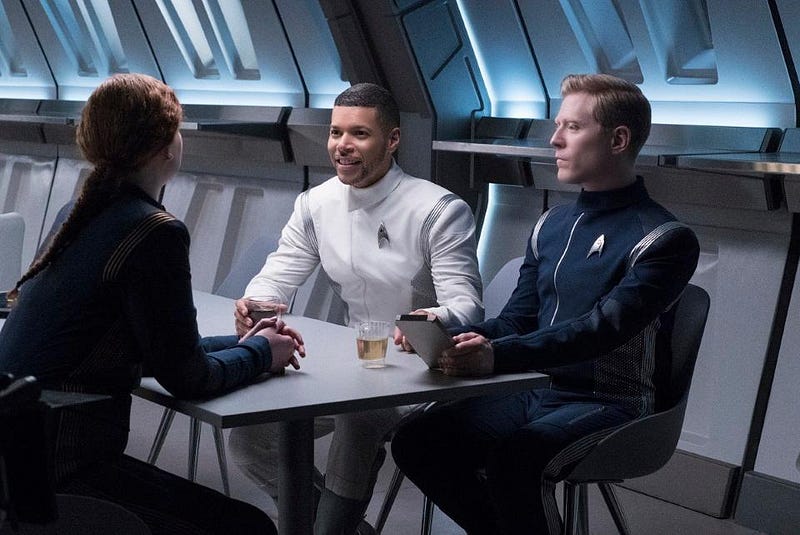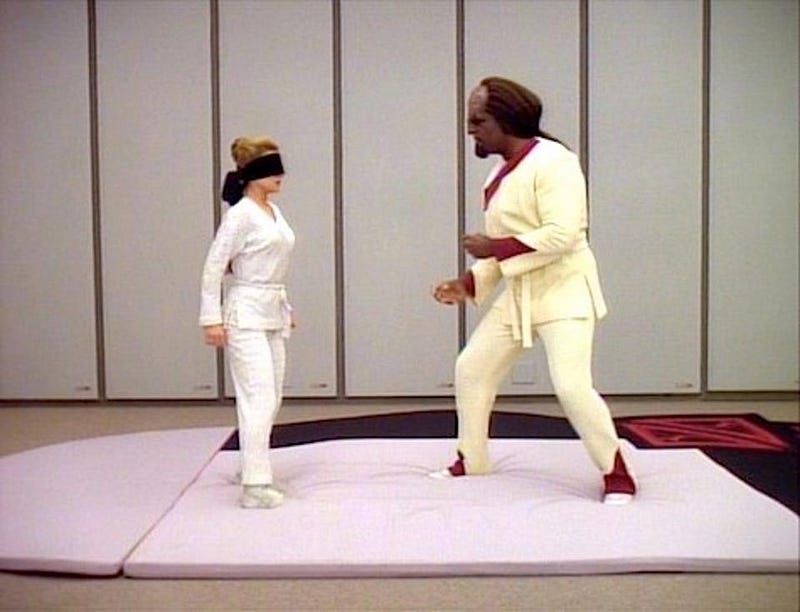Overwhelming Cloaking Devices And False Peace Highlights Star Trek: Discovery, Season 1 Episode 8

Right and wrong has never been so gray in the Star Trek Universe.
Imagine you’re in a fight with an enemy, and the fight itself isn’t fair. You might have comparable offensive and defensive capabilities; you might have comparable speeds and maneuverability; but they can see you and you can’t see them. It’s as though you were fighting a sighted enemy while you yourself were blind. The Klingon “Ship of the Dead” from Star Trek: Discovery demonstrated that cloaking technology early on in the series, defeating Starfleet, the USS Europa, and Admiral Brett Anderson in the Battle of the Binary Stars. Now that it’s been repaired and fallen under the control of Kol, the entire Klingon armada is equipped with the power of invisibility. How can the Federation stand, in war, against that kind of imbalance? That’s where Star Trek: Discovery’s eighth episode, “Si Vis Pacem, Para Bellum,” picks up.

Recap: “If you want peace, prepare for war,” goes the old Latin saying. In this case, the Federation has no choice. Their ships are under attack, and the enemy hunting them has an overwhelming tactical advantage. The USS Discovery, the most powerful weapon in the Federation’s arsenal thanks to its Stamets-powered spore drive, responds to a distress call from the USS Gagarin, under attack from six Klingon ships. Although Discovery fights bravely, its inability to effectively target and attack the cloaking and decloaking Klingon ships renders it incompetent in this situation, and the Gagarin is destroyed. It’s a theme that plays out over and over throughout history, where a game-changing military technology renders one side a defenseless, sitting duck in combat, and the cloaking device plays that role here.
The Federation has a hope, however: the world of Pahvo has unique, sonar-like properties, that they think could be utilized to help locate cloaked vessels. Saru, Tyler, and Burnham go down to the surface to investigate. The world is initially a nightmare for Saru, whose enhanced senses as a Kelpian (a highly-evolved prey species) make his presence on Pahvo like being in an acoustic torture chamber. The alien world itself is visually stunning, with sweeping vistas unlike anything on Earth, giving it an immersive beauty that has been a masterful hallmark of the new series so far. The three crewmembers encounter a blue, swirling energy glow that appears to be conscious, yet no one has ever successfully communicated with them before. As they quickly figure out, they are making first contact with a new type of live as they encounter the Pahvians.

The first night there is full of wonder for Burnham and Tyler, as they share a romantic moment and their first kiss. (At least, their first kiss in a timeline where they don’t explode.) Saru, on the other hand, is being tortured by the cacophony around him, and is spurred to make even deeper contact with the Pahvans that first night. As we enter his mind, we can hear his thoughts about who he is and why he’s there:
“Can you please make it stop, even for a moment? We were biologically determined for one purpose and one purpose alone: to sense the coming of death. I sense it coming now. We have come to Pahvo for your help. We have come to end this war. I am so afraid. So. Afraid.”
The encounter brings Saru an inner peace he’s never known: a moment without fear. It’s played beautifully by Doug Jones, and draws the audience’s sympathy even as we realize that he’s been compromised as far as the mission goes.
Burnham leaves to go combine Pahvo’s natural technology with the Federation’s own, in order to contact Discovery. Meanwhile, Tyler distracts Saru, buying her the necessary time. (I was really looking forward to seeing Saru run at his top speeds, described as 80 kph, which would be cheetah-like, but this effect failed to impress.) After a low-stakes conflict, Burnham and Tyler tell the full story of the war to the Pahvan energy field, Saru is despondent, and everyone returns to Discovery.

Over in sub-plot territory, Stamets’ mind is degenerating from the continued use of the spore drive, as Tilly draws out of him that he’s unable to remember basic things. We also get a hint that, apparently, he’s seeing through time somewhat, as he calls Cadet Tilly “Captain” at one point, hearkening back to Burnham’s inspirational cadet-to-captain speech that she gave to Tilly earlier. Over in Klingon-land, L’Rell is unhappy with Kol for a variety of reasons, and then learns of her murdered allies at his hands. She convinces Kol that she’s a skilled interrogator, which is a ruse to escape with Admiral Cornwell. She gets busted, so stages a fight and knocks Cornwell out (nobody believes she’s dead, do you?), but Kol sees through her ruse and busts her.
At the end, the Pahvans are transmitting a super-powerful signal to both the Federation and the Klingons, which draws the Ship of the Dead to Pahvo. Will their signal enable Discovery to “see” cloaked ships? No doubt, a big fight is on its way.
The Science: The impetus for this episode, the cloaking device, has been revealed many times before in Star Trek. This effective invisibility is incredibly powerful, and led to the destruction of the USS Gagarin. (Happy to see a reference to Yuri Gagarin in this episode: the first human in space!) But unlike in previous iterations of Star Trek, this technology, in 2017, is well on its way to becoming a reality. Owing to multilayered metamaterials, which can bend light of various wavelengths around an object and allow it to continue on its original path, a cloaking device across a great many wavelengths of light is already a reality.

We have yet to do this for the full gamut of electromagnetic radiation, however: we can’t quite cover the visible light spectrum or shorter-wavelength (higher-energy) light. There’s no reason to believe we won’t be able to cover at least the optical portion of the spectrum in the relatively near future, and when we do, that’s when we’ll have achieved a true “invisibility” cloak. If you look at an object and all you can see is what’s behind it, that’s effective invisibility. It’s a technology that’s well on its way, even now in 2017. 200+ years from now, it’s kind of a wonder to imagine that only the Federation’s enemies would possess it.
The rest of the science in the episode is fuzzy, at best. Last episode — the best of the series, in my opinion — used the previously established technologies to tell a compelling, character-driven story that was interesting in its own right. This week, we went back to, “hey, you know what we don’t understand very well, yet? Brains. So let’s make up a bunch of mental and psychic stuff and bring that into the show.” It’s true that we’re still learning very much about brains, consciousness, and what makes a being sentient, but between Sarek and Burnham’s mindlink, Stamets’ mental connection with the spore drive, and now the Pahvans’ mind-reading/communicative abilities, it’s beginning to feel like Betazoids on steroids. It’s unfortunate that they keep introducing new, unscientific plot devices to tell these stories. I don’t want this incarnation of Star Trek to become space fantasy instead of science-fiction, but I may not get a choice here.

On the other hand, though, the depiction of Stamets grappling with what appear to be the early stages of some type of dementia are not only accurate, they’re heartbreakingly reminiscent of the mental decay I watched in many of my own relatives in their 70s and 80s. Even though it’s clearly caused by interaction with the spore drive itself, rather than any natural disease, the symptoms are the same, and are portrayed stunningly by Anthony Rapp. Saru, as well, is shaping up to be one of the most compelling and curious characters on the show. We all have some degree of anxiety we carry around with us, but owing to his Kelpian nature, Saru is always on high alert. His fleeting moments of peace and quiet are something we all wish for him (and ourselves), even as we know they cannot last.

Right and wrong: Lines always get blurred in times of war, as the cost of steadfastly adhering to your highest principles could lead to far worse outcomes and consequences than violating them. In that case, to paraphrase a brilliant quote from another sci-fi series (Battlestar Galactica), you can’t be so hellbent on doing the right thing that you fail to do the smart thing. Was it right to utilize the Pahvan’s resources for your own communications — and presumably, your own military — needs? Well, it violates the protocol for First Contact, and it probably violates the Prime Directive, too, but it’s not such a black-and-white case of right and wrong.
The dilemma reminded me, very much, of the TNG episode “Lower Decks,” when Worf told Ensign Sito Jaxa that she must pass a Klingon test called the Gik’tal, where they engage in hand-to-hand combat, where she is blindfolded and Worf is not. After being beaten, badly, numerous times, and restarting equally many times, she finally declares that the test itself is unfair. Worf agrees, and tells her, “But perhaps the next time you are judged unfairly, it will not take so many bruises for you protest.” The Federation is doing very poorly, thus far, in the war against the Klingons. Perhaps a game-changing technology is what’s needed for victory.

So, with that said, was it even a smart move? That remains to be seen. If the Federation gains technology that can enable them to see cloaked vessels, then it’d be easy to argue it was worth it. If they can lure Kol’s flagship to this location and defeat them (and even capture him), it’s the greatest outcome you could have asked for. But if he defeats you and destroys Pahvo, you’ve stepped in it in the worst possible way. It’s an interesting consideration to realize that what turns out to be right or wrong is outcome-dependent, not intention-dependent. This is a lesson that the show is practically clubbing Burnham over the head with — Lorca even directly tells her that she’s responsible for the danger Pahvans are creating (and she denies it) — and I am curious as to whether she’ll ever realize it.

What’s also interesting to me about this episode is the good uses of betrayals and deceit that comes about. Tyler and Burnham “betray” Saru, but it’s a betrayal that’s necessary to save him, themselves, and (arguably) the Federation. L’Rell betrays Kol, but she does so because following him would be dishonorable given the atrocities he’s committing. (Note that she has no love or loyalty for the Federation, and that Admiral Cornwell is only treated well in that she’s useful to L’Rell.) And in his own way, Stamets is betraying Culber and Discovery by attempting to hide the effects that spore drive is having on him, physiologically. But in all these cases, the betrayals are in service of a selfless, greater good. It’s an interesting consideration, and I’m pleased that Star Trek: Discoveryis making us think about them.

Conclusion: The jury is out on this episode, which clearly serves as a setup for the mid-season finale airing next week. I liked the overwhelming power associated with the cloaking device, as it really would be this much of a game-changer. I loved the character development of Saru, and I think the ethical questions being raised are interesting, although I’d like to see them addressed more directly. But perhaps that’s me wanting a throwback to the bygone eras of Picard and Sisko, and a show that demonstrates rather than alludes to these issues. For what it is, the eighth episode of Star Trek: Discovery, Si Vis Pacem, Para Bellum, sets up an incredible battle very well. The next one will be for all the marbles.
Ethan Siegel is the author of Beyond the Galaxy and Treknology. You can pre-order his third book, currently in development: the Encyclopaedia Cosmologica.





